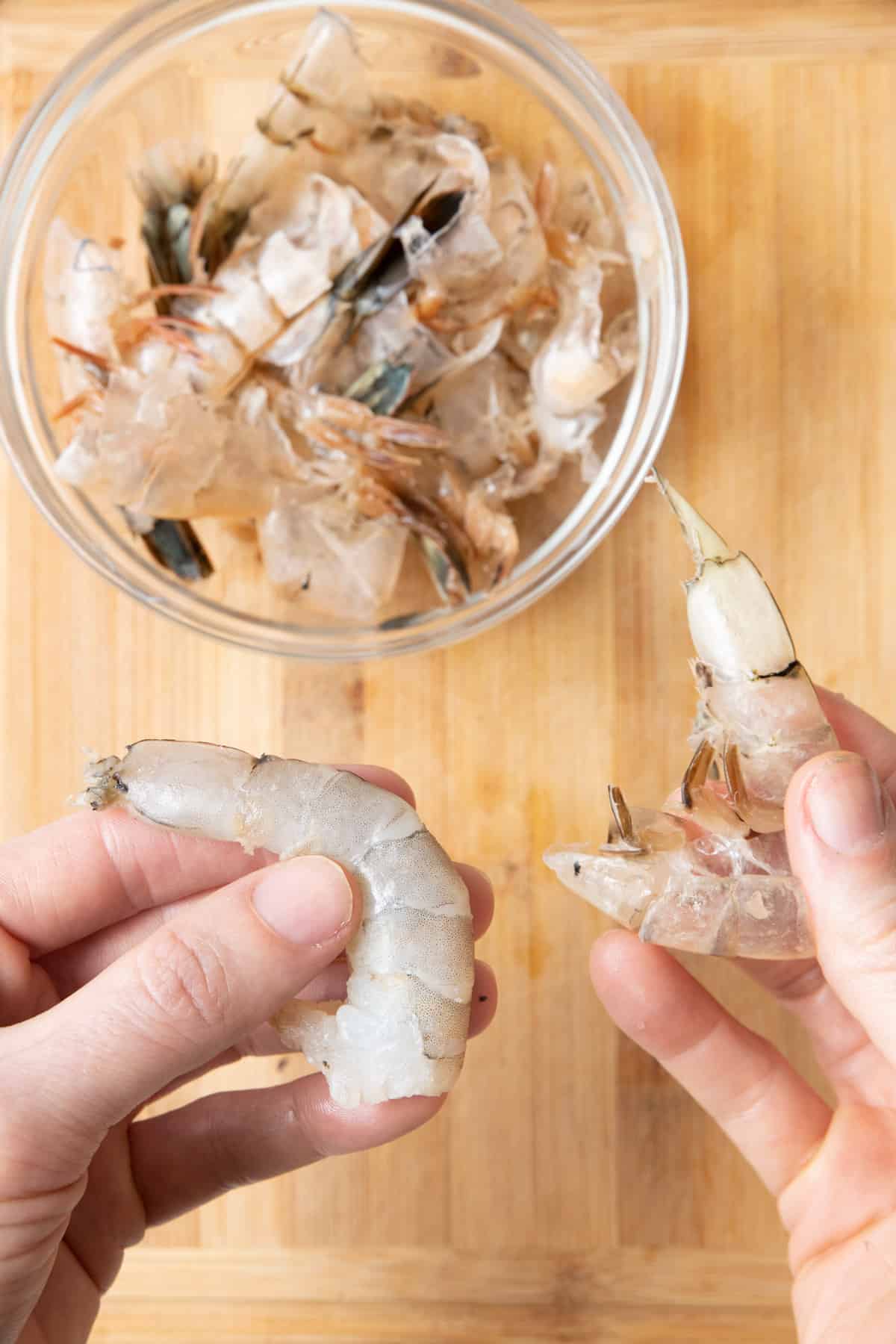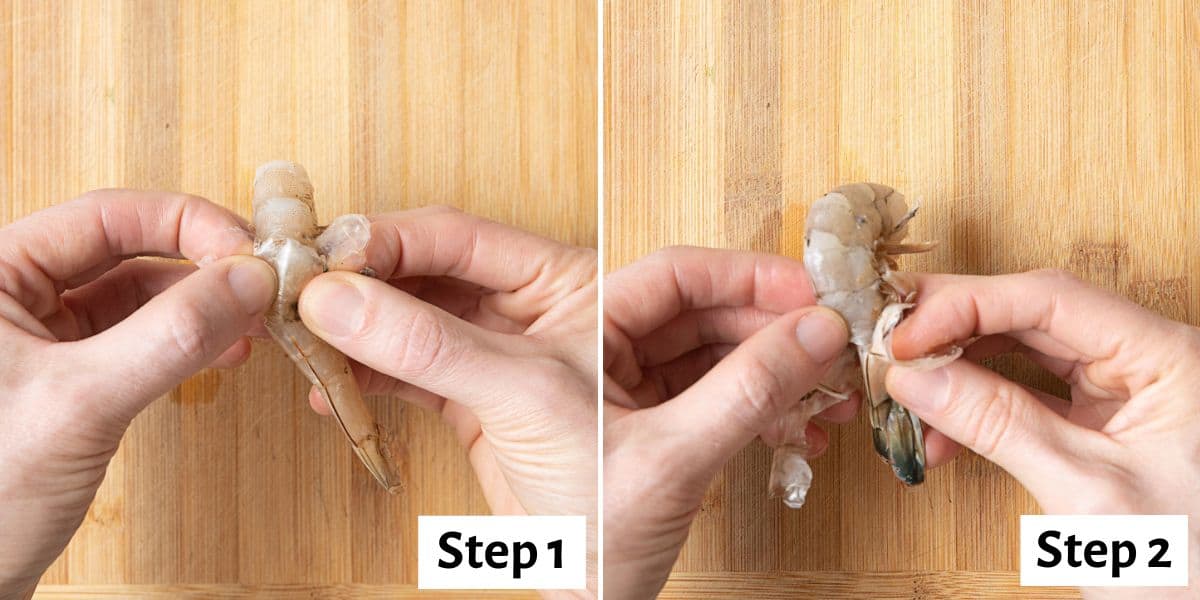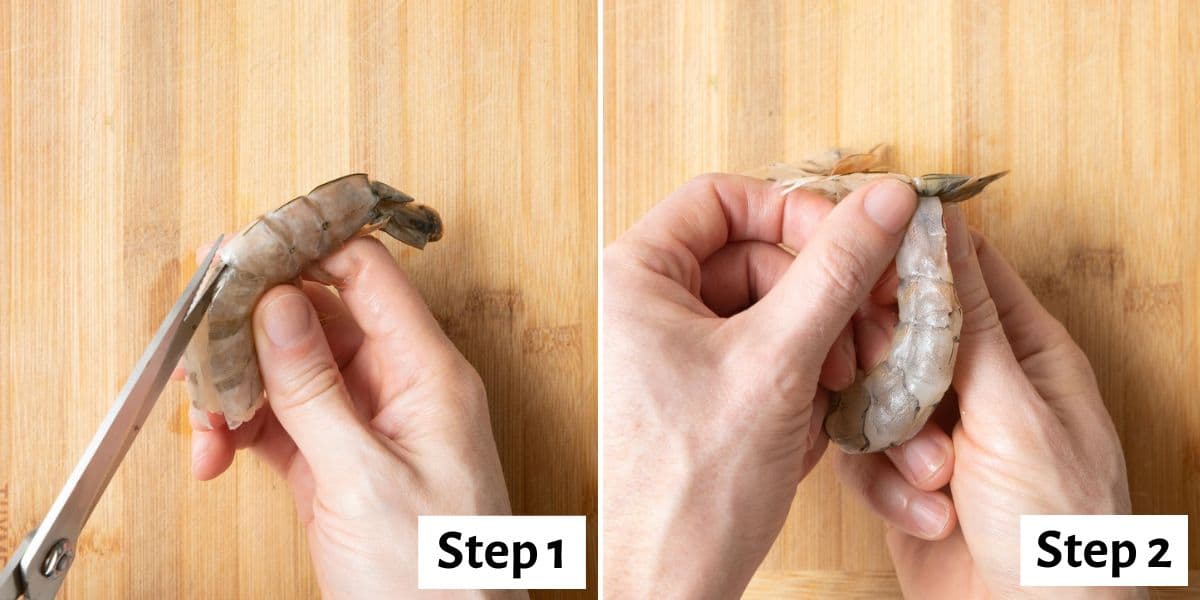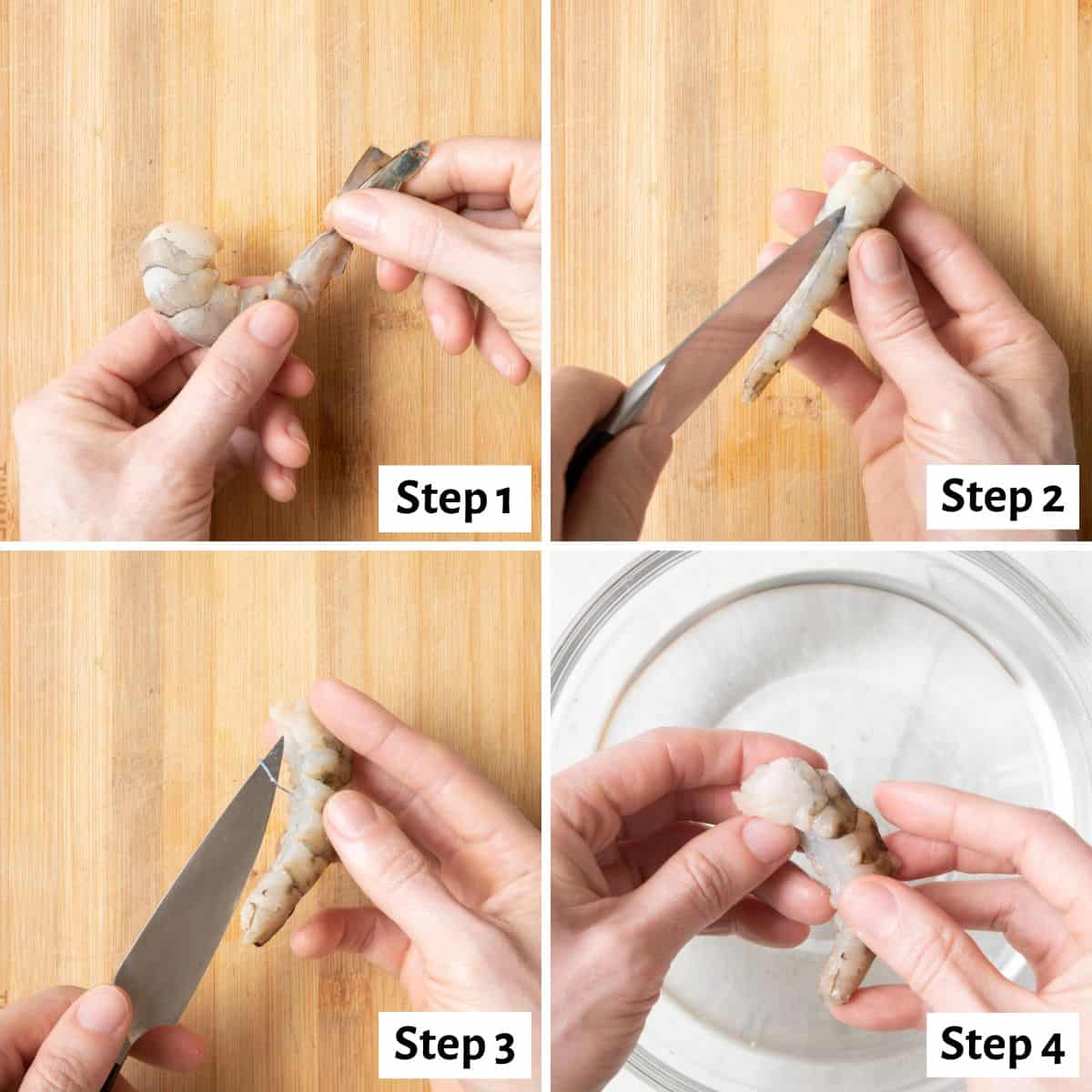This post may contain affiliate links. Please read our disclosure policy.
Peeling shrimp might seem like a chore, but it’s actually a simple skill that comes in handy. Whether you’re preparing a seafood feast or adding shrimp to a salad, pasta, or stir-fry, knowing how to peel shrimp properly is essential. I’ll walk you through the steps of how to peel shrimp both with your hands and with kitchen shears. It’s a handy technique that’s easier than you might think and can save you both time and effort in the kitchen.

Table of Contents
The method you choose to peel shrimp should depend on personal preference and what tools you have available. Some people find it quicker to peel shrimp with their hands, while others prefer the precision of kitchen shears. Plus, I’ll show you how to devein the shrimp – an important step to ensure they are clean and ready to cook.
Why learn how to peel shrimp
- Customize to your preference and recipe. Peeling shrimp at home gives you the flexibility to customize depdning on what you like and what the recipe calls for: tail-on, tail-off, legs on, legs off!
- Cost efficient. Learning how to peel shrimp at home is a budget-friendly skill, especially if cooking for larger gatherings. Buying shrimp in shells is often more cheaper than buying pre-peeled shrimp because you’re not paying for the convenience of peeled shrimp.
- Gain a great skill. Learning how to peel and devein raw shrimp is a fundamental skill that that will make you feel more confident in the kitchen, right there along with making homemade tortillas, mirepoix, and yogurt.

- Raw shrimp with shell-on: Grab a bag of frozen shrimp from the supermarket and let it thaw first. You can use this method to peel shrimp of any size in any quantity.
How to Peel Shrimp (Video Tutorial)
How to peel and devein raw shrimp
Learn how to peel shrimp in the shell quickly and efficiently with these simple tips and tricks. You will learn to peel shrimp using your hands, kitchen shears, with the tail on or off – whatever your heart and recipe calls for – you can be sure you’ll find the how-to here.
Peel shrimp with your hands
- Use your thumbs to crack the shrimp shell.
- Peel the shell away from the shrimp and discard.

Peel shrimp with kitchen shears
- Use a pair of kitchen shears to carefully make a cut at the top of the shrimp along its length until you reach the tail.
- Peel the shell away from the shrimp and discard.

How to devein shrimp with shell on
- To remove the shrimp tail, pinch it at the end of the shrimp body where it starts to feel hollow, and gently pull to separate the tail from the rest of the shrimp.
- Use a sharp paring knife or your fingers to make a shallow cut along the back of the shrimp, being careful not to cut too deep.
- Use the tip of the knife or your fingers to pull out the vein (it will look like a long black and gritty string), which runs along the back of the shrimp.
- Rinse the shrimp under cold running water to remove any remaining debris, and then use as desired.

Tips for peeling shrimp fast
- Start with chilled shrimp. Place the shrimp in the freezer for 15-20 minutes before peeling. This slight chill makes the shells firmer and easier to handle.
- Keep a bowl of water close by. Having a bowl of cold water nearby to rinse your hands keeps your hands clean and free from sticky shrimp shells or other residue.
- Practice mise en place. This is a French term that refers to having all of your tools prepared for efficient workflow. This includes a bowl for discarded shells, kitchen shears, bowl of cold water for rinsing, a small knife, and a designated space for peeling.
- Keep the tails on. Leaving the tail on the shrimp prevents them from drying out during cooking. This is especially helpful when cooking shrimp in dry heat methods such as grilling.
Recipes to make with peeled shrimp
- Easy Shrimp Tacos
- BBQ Grilled Shrimp
- Lemony Garlic Shrimp
- Mediterranean Couscous with Shrimp
- Easy Shrimp Fajitas
- Shrimp Scampi with Spaghetti Squash
How to store peeled shrimp
Store raw peeled shrimp in an airtight container in the refrigerator.
How long will shrimp last in the fridge?
Raw shrimp will last in the fridge for up to 2 days. If you will not consume the shrimp within that time frame, consider freezing them.
Can I freeze peeled shrimp?
Yes, you can freeze peeled shrimp for up to 3 months. First, flash freeze by laying the peeled shrimp on a baking sheet in a single layer and freeze until solid. Once frozen, transfer them to an airtight freezer bag, removing as much air as possible to prevent freezer burn. Flash freezing will prevent the shrimp from sticking to each other.
Thaw overnight in the fridge and use as desired in recipes.
Frequently asked questions
The vein in shrimp is edible but can be quite unsightly and have a gritty texture. While deveining shrimp is optional, it lends a cleaner presentation and improved taste. So even though it’s a personal preference, I think most people will appreciate the extra effort in deveined shrimp.
The decision to peel shrimp before or after cooking often comes down to the recipe you’re using and personal preference. Both methods have their advantages:
Peeling Before Cooking:
Flavor Absorption: Peeled shrimp can absorb marinades and seasonings more effectively, enhancing their flavor.
Ease of Eating: For dishes where shrimp is mixed with other ingredients, like pasta or salad, peeling beforehand makes it easier to eat.
Texture: Direct exposure to heat can result in a slightly different texture, often preferred in certain recipes.
Peeling After Cooking:
Flavor Preservation: Cooking shrimp in their shells can help preserve the shrimp’s natural flavor and juiciness.
Easier Peeling: Some find that the shells come off more easily after cooking, as the flesh tends to shrink away from the shell.
Presentation: For visual appeal, especially in dishes like shrimp cocktail, leaving the shell on during cooking can make for a more attractive presentation.
Ultimately, the choice depends on the specific requirements of the dish you’re preparing and your own preferences regarding flavor, texture, and convenience.
Yes, you can save the shrimp shells to make a delicious shrimp stock. Consider simmering them with aromatics like onion and garlic to make seafood broth for soups.

Knowing how to peel raw shrimp opens up a world of delicious possibilities. Beyond the satisfaction of mastering this basic culinary skill, you’ll be able to quickly prepare delicious dishes that let the natural flavors of shrimp shine.
More cooking tutorials:
- How to Make Shrimp Cocktail
- How to Cook Lobster Tail
- How to Brown Ground Beef
- How to Grill Chicken Thighs
- How to Press Tofu
- How to Cut a Whole Chicken
- How to Grill Steak
- How to Make Shredded Chicken
- How to Bake Tofu
- How to Poach Chicken
If you found this tutorial for How to Peel Shrimp helpful or if you try any recipe on Feel Good Foodie, then don’t forget to rate the recipe and leave a comment below! It helps others who are thinking of trying out this tutorial and we would love to hear about your experience. And if you snapped some shots, share it on Instagram so we can repost on Stories!

order MY book
The Feel Good Foodie Cookbook is now available everywhere books are sold!
Amazon TargetBarnes & Noble Books A Million Hudson Booksellers BookshopSCHULER Books

How to Peel Shrimp
Video
Ingredients
- 1 pound Raw shrimp with shell on any size
Instructions
- Peel the shrimp with your hands: Use your thumbs to crack the shrimp shell and then peel it away from the shrimp and discard.
- Peel the shrimp with kitchen shears: Alternatively, use kitchen shears to carefully make a cut at the top of the shrimp along its length until you reach the tail. Peel the shell away from the shrimp and discard.
- You can keep the tail on for cooking, or if you prefer to remove it, pinch the tail at the end of the shrimp body where it starts to feel hollow and gently pull to separate the tail from the rest of the shrimp.
- Use a sharp paring knife or your fingers to make a shallow cut along the back of the shrimp, being careful not to cut too deeply.
- Use the tip of the knife or your fingers to pull out the vein (it will look like a long black and gritty string), which runs along the back of the shrimp.
- Rinse the shrimp under cold running water to remove any remaining debris. Then use as desired.
Notes
Nutrition
Nutrition information provided is an estimate. It will vary based on cooking method and specific ingredients used.





